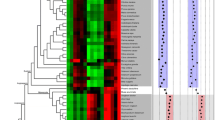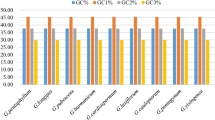Abstract
Codon usage in mitochondrial genome of the six different plants was analyzed to find general patterns of codon usage in plant mitochondrial genomes. The neutrality analysis indicated that the codon usage patterns of mitochondrial genes were more conserved in GC content and no correlation between GC12 and GC3. T and A ending codons were detected as the preferred codons in plant mitochondrial genomes. The Parity Rule 2 plot analysis showed that T was used more frequently than A. The ENC-plot showed that although a majority of the points with low ENC values were lying below the expected curve, a few genes lied on the expected curve. Correspondence analysis of relative synonymous codon usage yielded a first axis that explained only a partial amount of variation of codon usage. These findings suggest that natural selection is likely to be playing a large role in codon usage bias in plant mitochondrial genomes, but not only natural selection but also other several factors are likely to be involved in determining the selective constraints on codon bias in plant mitochondrial genomes. Meantime, 1 codon (P. patens), 6 codons (Z. mays), 9 codons (T. aestivum), 15 codons (A. thaliana), 15 codons (M. polymorpha) and 15 codons (N. tabacum) were defined as the preferred codons of the six plant mitochondrial genomes.




Similar content being viewed by others
References
Grantham R, Gautier C, Gouy M (1980) Codon frequencies in 119 individual genes confirm consistent choices of degenerate bases according to genome type. Nucleic Acids Res 8:1893–1912
Angellotti MC, Bhuiyan SB, Chen G et al (2007) CodonO: codon usage bias analysis within and across genomes. Nucleic Acids Res 35:132–136
John F (1999) Analysis of codon usage. The University of Nottingham for the Degree of Doctor of Philosophy, August
Gouy M, Gautier C (1982) Codon usage in bacteria, correlation with gene expressivity. Nucleic Acids Res 10:7055–7074
Stenico M, Lloyd AT, Sharp PM (1994) Codon usage in Caenorhabditis elegans, delineation of translational selection and mutational biases. Nucleic Acids Res 22:2437–2446
Sharp PM, Bailes E, Grocock RJ et al (2005) Variation in the strength of selected codon usage bias among bacteria. Nucleic Acids Res 33:1141–1153
Sharp PM, Stenico M, Peden JF et al (1993) Codon usage, mutational bias, translational selection, or both? Biochem Soc Trans 21:835–841
Karlin S, Mrázek J (1996) What drives codon choices in human genes? J Mol Biol 262:459–472
Francino HP, Ochman H (1999) Isochores result from mutation not selection. Nature 400:30–31
Powell JR, Moriyama EN (1997) Evolution of codon usage bias in Drosophila. Proc Natl Acad Sci USA 94:7784–7790
Wang HC, Hickey DA (2007) Rapid divergence of codon usage patterns within the rice genome. BMC Evol Biol 7(suppl 1):S6
Ingvarsson PK (2007) Gene expression and protein length influence codon usage and rates of sequence evolution in Populus tremula. Mol Biol Evol 24:836–844
Kawabe A, Miyashita NT (2003) Patterns of codon usage bias in three dicot and four monocot plant species. Genes Genet Syst 78:343–352
Saccone C, Gissi C, Reyes A et al (2002) Mitochondrial DNA in Metazoa, degree of freedom in a frozen event. Gene 286:3–12
Le TH, McManus DP, Blair D (2004) Codon usage and bias in mitochondrial genomes of parasitic platyhelminthes. Korean J Parasitol 42:159–167
Jia W, Higgs PG (2008) Codon usage in mitochondrial genomes, distinguishing context-dependent mutation from translational selection. Mol Biol Evol 25:339–351
Wright F (1990) The ‘effective number of codons’ used in a gene. Gene 87:23–29
Chiapello H, Fisacek F, Caboche M et al (1998) Codon usage and gene function are related in sequences of Arabidopsis thaliana. Gene 209:1–38
Wright SI, Yau CBK, Looseley M (2004) Effects of gene expression on molecular evolution in Arabidopsis thaliana and Arabidopsis lyrata. Mol Biol Evol 21:1719–1726
Sueoka N (1988) Directional mutation pressure and neutral molecular evolution. Proc Natl Acad Sci USA 85:2653–2657
Ikemura T (1985) Codon usage and tRNA content in unicellular and multicellular organisms. Mol Biol Evol 2:13–34
Sueoka N (1999) Translation-coupled violation of parity rule 2 in human genes is not the case of heterogeneity of the DNA G + C content of third codon position. Gene 238:53–58
Sharp PM, Cowe E, Higgins DG et al (1988) Codon usage in Escherichia coli, Bacillus subtilis, Saccharomyces cerevisiae, Schizosaccharomyces pombe, Drosophila melanogaster and Homo sapiens; a review of the considerable within-species diversity. Nucleic Acids Res 16:8207–8711
Sueoka N, Kawanishi Y (2000) DNA G + C content of the third codon position and codon usage biases of human genes. Gene 261:53–62
Blake WJ, Kaern M, Cantor CR et al (2003) Noise in eukaryotic gene expression. Nature 422:633–637
Wan XF, Xu D, Kleinhofs A et al (2004) Quantitative relationship between synonymous codon usage bias and GC composition across unicellular genomes. BMC Evol Biol 4:19
Lu H, Zhao WM, Zheng Y et al (2005) Analysis of synonymous codon usage bias in Chlamydia. Acta Biochim Biophys Sin 37:1–10
Bonitz SG, Berlani R, Coruzzi G et al (1980) Codon recognition rules in yeast mitochondria. Proc Natl Acad Sci USA 77:3167–3170
Pfitzinger H, Guillemaut P, Weil JH et al (1987) Adjustment of the tRNA population to the codon usage of chloroplasts. Nucleic Acids Res 15:137
Xia X (1998) How optimized is the translational machinery in Escherichia coli, Salmonella typhimurium and Saccharomyces cerevisiae? Genetics 149:37–44
Lynn DJ, Singer GA, Hickey DA (2002) Synonymous codon usage is subject to selection in thermophilic bacteria. Nucleic Acids Res 30:4272–4277
Liu QP, Xue QZ (2005) Comparative studies on codon usage pattern of chloroplasts and their host nuclear genes in four plant species. J Genet 84:55–62
Liu Q, Feng Y, Xue Q (2004) Analysis of factors shaping codon usage in the mitochondrion genome of Oryza sativa. Mitochondrion 4:313–320
Morton BR (1998) Selection on the codon bias of chloroplast and cyanelle genes in different plant and algal lineages. J Mol Evol 46:449–459
Morton BR (1999) Strand asymmetry and codon usage bias in the chloroplast genome of Euglena gracilis. Proc Natl Acad Sci USA 96:5123–5128
Morton BR, So BG (2000) Codon usage in plastid genes is correlated with context, position within the gene, and amino acid content. J Mol Evol 50:184–193
Acknowledgments
This work was supported in part by the National High Tech Development Project of China, the 863 Program (Grant Nos. 2007AA02Z329) and the National Natural Science Foundation of China (Grant Nos. 20060213024).
Author information
Authors and Affiliations
Corresponding author
Rights and permissions
About this article
Cite this article
Zhou, M., Li, X. Analysis of synonymous codon usage patterns in different plant mitochondrial genomes. Mol Biol Rep 36, 2039–2046 (2009). https://doi.org/10.1007/s11033-008-9414-1
Received:
Accepted:
Published:
Issue Date:
DOI: https://doi.org/10.1007/s11033-008-9414-1




